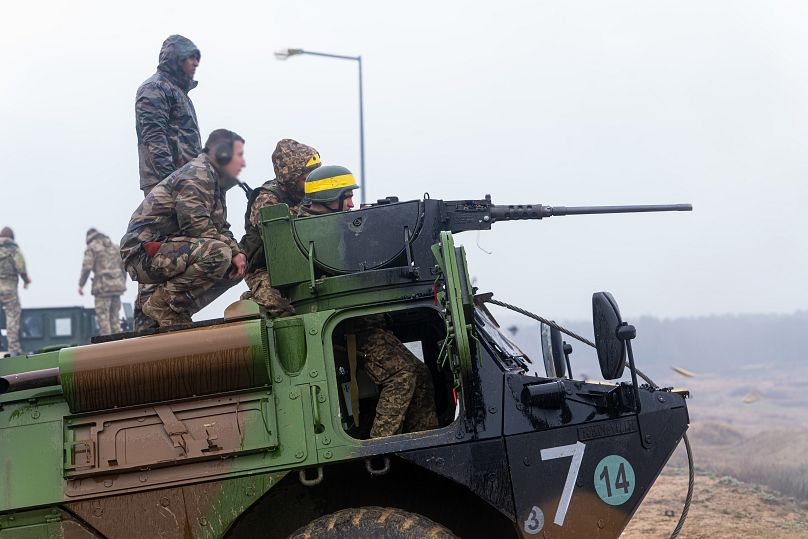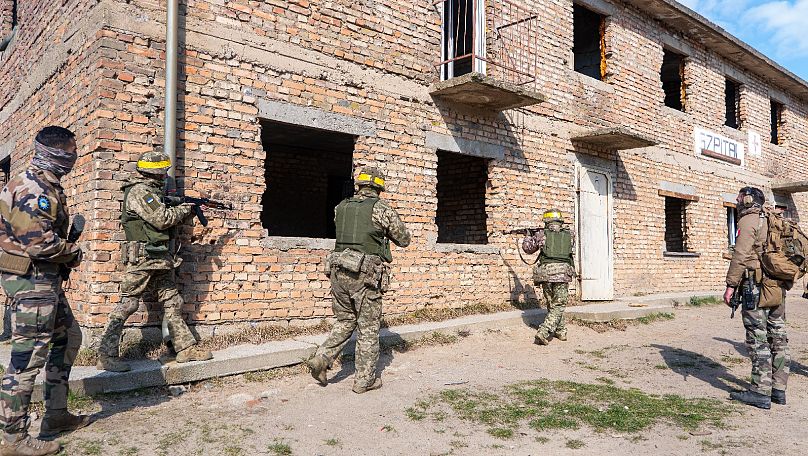France is training Ukrainian troops in Poland through an EU mission to sharpen the key skills they will need on the battlefield back home. Euronews followed the training for a day.
The armoured vehicle skids to a halt in front of the trench and out bursts half a dozen Ukrainian soldiers. Within seconds, smoke grenades obscure the scene, and the sound of gunshots rips through the air.
The clear blue sky makes it easier for the Ukrainians to hear the drone flying dozens of metres overhead but confusion ensues: is the drone commandeered by one of their own or by the enemy? A Ukrainian soldier briefly shoots at it but then shifts his focus instead to the 200 metres of trench lying ahead. Speed, here, is of the essence.
Thirty minutes later, the Ukrainians have safely detonated several booby traps, wrestled the trench from the enemy’s control, and are now tending to a wounded comrade.
The injury, however, was fake. The bullets were blanks. The enemy was not Russian but French and the trench was not on the eastern Ukrainian frontline but rather on a Polish military base.
The assault was instead part of a training French troops provided to their Ukrainian counterparts through the EU Military Assistance Mission (EUMAM).
“We’re approaching the three-quarter mark of the training,” Lieutenant-Colonel Louis, whose last name is withheld for security reasons, told Euronews. “We’re not at the end yet, but we’re starting to work on inter-service and slightly more complex exercises where we go beyond basic skills. We’re starting to work on manoeuvres.”
“The aim is to get them to command their unit, observe any mistakes they may make and then debrief the battle afterwards,” he added.
This is the fourth Ukrainian battalion receiving a month-and-a-half-long training from the French military in Poland. They are among the more than 10,000 Ukrainian troops to have been trained by France – in Poland and across multiple sites in France - in the year and a half since EUMAM was launched.
The 24 EU member states taking part in EUMAM have so far collectively trained 46,000 Ukrainian soldiers.
Each provides different training based on what Ukraine needs and their own specialities. Poland, Ukraine’s neighbour, hosts many of these programmes, foots the bill for the accommodation, equipment, and ammunition used and gets some of the costs reimbursed by the EU.
The UK has also trained another 36,000 Ukrainian soldiers on its soil.
'If they don't like it, we know very quickly'
The French training is all about the infantry basics, including how to shoot their standard-issue guns and mortars, decipher a map or drone observations to assist in shooting, keep a defensive position, give basic medical care, drive the vehicles France donates and crucially who should do what when.
The keyword for French instructors is “adaptability,” Colonel Antoine Laparra, France’s Senior National Representative for EUMAM, stressed throughout the one-day observation trip for media that Euronews took part in late last month.
They need to adapt to the level of the soldiers Ukraine sends – some of whom have never seen the frontline – as well as to the Ukrainian leadership’s expectations. Feedback is sparse.
"If the training didn't suit them, they'd tell us, they don't have time to waste and politeness and finesse are not their hallmarks," Laparra said.
Euronews was not allowed to interview any of the Ukrainian soldiers taking part nor the translators – most of them Ukrainian women – whose work makes it all possible.
“During the previous mandate, the Ukrainians were sometimes very blunt and said no, we don't want that anymore. So when they don't like it, we know very, very quickly, so as long as they don't tell us they don't like it, that means they do,” the Colonel added.
In an emailed statement to Euronews, the Ukrainian Defence Ministry said: "It is very important to continue the training of Ukrainian military personnel within the framework of this mission."
"This enables Ukrainian defenders to master modern weapons and equipment to effectively repel Russian aggression. Over the course of EUMAM's activities, we have identified several aspects to improve the effectiveness of training. For example, the use of the train-the-trainers approach. This is important not only to meet existing defence needs, but also to develop the future capabilities of the Ukrainian Defence Forces," it added.
'There's definitely been an improvement'
The pitter-patter sound of bullets hitting their metal targets some 100m away can be heard amidst the gunshots, drawing a satisfied smile from the French soldiers overseeing the shooting training.
After more than three weeks on site, the fundamentals of shooting — how to hold the weapon, breathe and pull the trigger to hit the target — are more or less acquired so the day’s session has an added layer of tactical difficulty: the squad chief must ensure that the various sub-teams coordinate to shoot at different targets and keep enough ammunition to cover their comrades when they need to pull back.
The latter proved difficult for the squad chief this time around, a fact Lieutenant-Colonel Léa pointed out at the huddle after the exercise.
Still, she remained positive: “Today was a good exercise, they were very motivated and we can see that there's definitely been an improvement since the start of the training.”
Squad chiefs – who oversee about 10 soldiers under them - play a critical role in the French army, with special attention paid to them and the overall chain of command.
Ukrainian battalions are composed of people who were largely thrown into the deep end on February 24, 2022, when Russia started its full-scale invasion, and new arrivals who have never seen battle but now find themselves in leadership positions. Breaking down in granular detail how a proper chain of command operates is therefore key.
The need is such that the French have proposed that going forward, squad chiefs arrive a week early for intensive training. The Ukrainians have acquiesced.
A week is a far cry from the two years it takes to train a squad chief or sergeant in the French army, but Colonel Laparra is certain it can help.
“I'm convinced that if we consolidate this lower level, i.e. the squad, inevitably the general level of the larger unit, the company, will rise. It's so obvious that it can't be any other way.”
No expensive gadgets or weapons
One of the companies is tested later in the day. The task here is for them to reclaim an entire street in a training village flanked by multi-storey buildings. The company leader takes the time to outline his plan and then it’s go time.
Mistakes are made: an entire section – about three squads – all find themselves in the same building at the same time, several soldiers are too exposed to enemy fire in the windows, one is completely exposed on a rooftop. Several are tagged as wounded.
Ninety minutes later, the enemy soldiers lying in ambush have been neutralised and the street is under Ukrainian control. They get a passing grade. There's no time to rest though as in the coming days, the level of difficulty will be gradually ramped up with more enemy soldiers, more booby traps, and a wider perimeter to secure.
There is little artifice in what the French show the Ukrainians, no expensive gadgets or weapons, the reasoning being that most won’t have access to them. The French kit to detonate a booby trap includes a metres-long string roll and a snap hook, "tools" Ukrainians can all easily get.
One aspect the French don’t adapt to, however, is Kyiv’s standing in the war, its strategic decisions, losses and wins, casualties and dwindling firepower, which are not discussed at all in the month and a half the French and Ukrainians spend together.
The country is currently on the back foot, in large parts because it doesn’t have the ammunition to match Russia as production capacity in Europe sputters into war mode and US aid is stuck in Congress.
Asking them to ration their ammunition would be counterproductive, however, Euronews is told, because it might sap morale.
“Our objective is to give them the keys to cope, whether they're in difficulty or in a different dynamic. So it's not because they're in a more or less complicated tactical situation that we're going to change our instructions. We really give them the basic keys and fundamentals that enable them to resist and move forward,” Laparra said.
“Ukrainian soldiers hitting targets 100 metres away, that's already a success. We know that as a result, the cartridges that are going to be fired can be fired effectively. And it's the same for mortars. Making an effective firing message with effective observation, that's what's going to make the ammunition fired profitable.”













